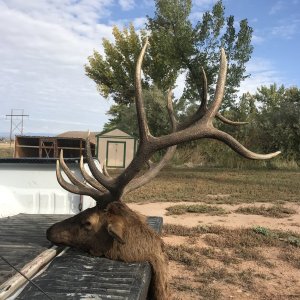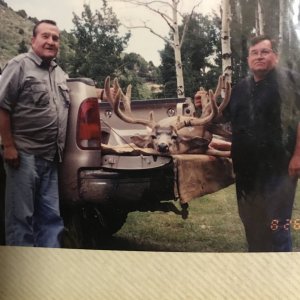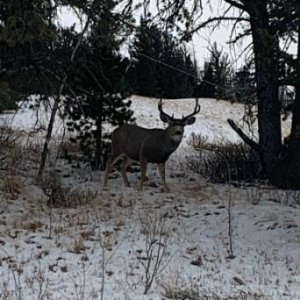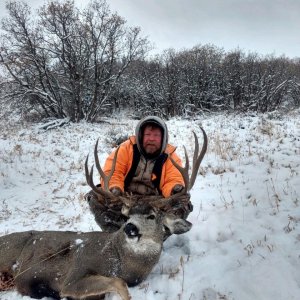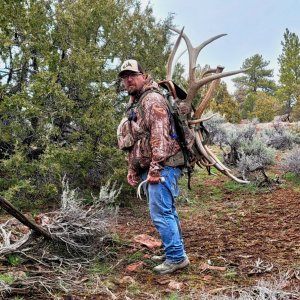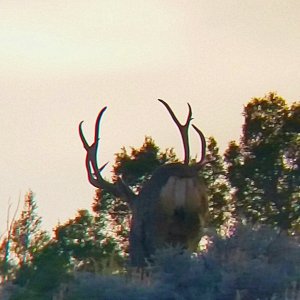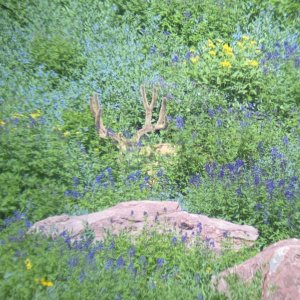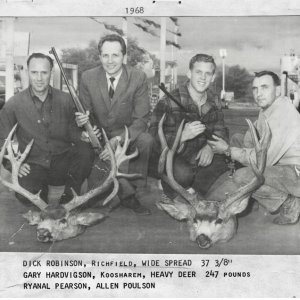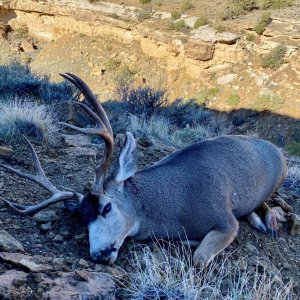Founder
Founder Since 1999
- Messages
- 11,469
RMEF Press Release I thought some of you might want to read.
-----------------------------------------------------
[font size=+1]Elk Country Athlete: 5 Ways to Train for Better Hunting[/font]
MISSOULA, Mont.?Wilderness elk hunting is an athletic endeavor but you don't need to kill yourself getting in shape. Cameron Hanes, fitness and bowhunting authority as well as TV show host and columnist for the Rocky Mountain Elk Foundation, says moderation in exercise is a key for most hunters.
?You don't have to be a world-class athlete to build up amazing endurance, but you do have to get started with some sort of workout regimen. Every day you spend in inactivity, you get weaker. Every day that elk move through high country, they get stronger. And the longer you wait to exercise, the wider the gap grows,? said Hanes.
Here are five ways to start closing the gap.
1. Try a ?commercial workout? when you're sitting around watching TV. Do push-ups and sit-ups during the commercials. Over the summer months, this exercise can make a big difference.
2. If you've been doing nothing recently, there's no point in running. Going overboard right out of the gate will only make you too sore, cause you to hurt yourself or burnout quickly. Go for a brisk walk instead. Walk for 10 minutes and slowly jog for five. Do this back-to-back for 30 minutes, four times a week, for a couple of weeks. Slowly begin to lengthen the overall workout, then start increasing the jogging time.
3. You needn?t spend tons of time. If you're at your ideal weight, you need just 30 minutes per day of exercise, minimum. If weight loss is a concern, experts say it takes an hour of exercise each day to lose weight without going on a diet. Thirty minutes will do for weight loss if you both diet and exercise.
4. Hard workouts are not always better. Some of the world?s greatest athletes exercise at ?conversation pace,? meaning their pace is easy enough to have a conversation while running. Even many Olympians workout at a comfortable pace 90 percent of the time. As you get into shape, try long (45 minutes or more) comfortable workouts three or four days a week. Then, one day a week, do a harder fast-paced workout.
5. Mix it up. Add some variety to your walking and jogging with cross-training and lifting weights?but keep in mind that almost everything you do in elk hunting begins and ends with your legs. Throw on your pack and climb hills or bleachers. Get on a bike. In the weight room, emphasize squats and lunges. Lots of reps are more important than heavy weights, because for elk hunting you need lean muscle, not size.
When hunting season arrives, Hanes says, remember to pace yourself. The endurance you've built over the summer will allow you hunt longer, not necessarily faster or harder. Many hunters tend to overexert at first and hit the wall quickly. Slow, steady hunting for longer periods gives you your best chance to take an elk.
While he admits it's not for everyone, Hanes prepares for elk season by training for and competing in ultramarathons, races up to 100 miles or more across high-elevation trails. His advice on workouts for hunters spans from basic suggestions for average people to highly technical info for elite athletes in elk country.
Hanes serves RMEF as host of ?Elk Chronicles? on Outdoor Channel and as a columnist for ?Bugle? magazine. His second book, ?Backcountry Bowhunting, A Guide to the Wild Side,? is available at www.cameronhanes.com and is currently in its fifth printing.
About the Rocky Mountain Elk Foundation:
Snowy peaks, dark timber basins and grassy meadows. RMEF is leading an elk country initiative that has conserved or enhanced habitat on over 5.6 million acres?a land area equivalent to a swath three miles wide and stretching along the entire Continental Divide from Canada to Mexico. RMEF also works to open, secure and improve public access for hunting, fishing and other recreation. Get involved at www.rmef.org or 800-CALL ELK.
-----------------------------------------------------
Brian Latturner
MonsterMuleys.com
-----------------------------------------------------
[font size=+1]Elk Country Athlete: 5 Ways to Train for Better Hunting[/font]
MISSOULA, Mont.?Wilderness elk hunting is an athletic endeavor but you don't need to kill yourself getting in shape. Cameron Hanes, fitness and bowhunting authority as well as TV show host and columnist for the Rocky Mountain Elk Foundation, says moderation in exercise is a key for most hunters.
?You don't have to be a world-class athlete to build up amazing endurance, but you do have to get started with some sort of workout regimen. Every day you spend in inactivity, you get weaker. Every day that elk move through high country, they get stronger. And the longer you wait to exercise, the wider the gap grows,? said Hanes.
Here are five ways to start closing the gap.
1. Try a ?commercial workout? when you're sitting around watching TV. Do push-ups and sit-ups during the commercials. Over the summer months, this exercise can make a big difference.
2. If you've been doing nothing recently, there's no point in running. Going overboard right out of the gate will only make you too sore, cause you to hurt yourself or burnout quickly. Go for a brisk walk instead. Walk for 10 minutes and slowly jog for five. Do this back-to-back for 30 minutes, four times a week, for a couple of weeks. Slowly begin to lengthen the overall workout, then start increasing the jogging time.
3. You needn?t spend tons of time. If you're at your ideal weight, you need just 30 minutes per day of exercise, minimum. If weight loss is a concern, experts say it takes an hour of exercise each day to lose weight without going on a diet. Thirty minutes will do for weight loss if you both diet and exercise.
4. Hard workouts are not always better. Some of the world?s greatest athletes exercise at ?conversation pace,? meaning their pace is easy enough to have a conversation while running. Even many Olympians workout at a comfortable pace 90 percent of the time. As you get into shape, try long (45 minutes or more) comfortable workouts three or four days a week. Then, one day a week, do a harder fast-paced workout.
5. Mix it up. Add some variety to your walking and jogging with cross-training and lifting weights?but keep in mind that almost everything you do in elk hunting begins and ends with your legs. Throw on your pack and climb hills or bleachers. Get on a bike. In the weight room, emphasize squats and lunges. Lots of reps are more important than heavy weights, because for elk hunting you need lean muscle, not size.
When hunting season arrives, Hanes says, remember to pace yourself. The endurance you've built over the summer will allow you hunt longer, not necessarily faster or harder. Many hunters tend to overexert at first and hit the wall quickly. Slow, steady hunting for longer periods gives you your best chance to take an elk.
While he admits it's not for everyone, Hanes prepares for elk season by training for and competing in ultramarathons, races up to 100 miles or more across high-elevation trails. His advice on workouts for hunters spans from basic suggestions for average people to highly technical info for elite athletes in elk country.
Hanes serves RMEF as host of ?Elk Chronicles? on Outdoor Channel and as a columnist for ?Bugle? magazine. His second book, ?Backcountry Bowhunting, A Guide to the Wild Side,? is available at www.cameronhanes.com and is currently in its fifth printing.
About the Rocky Mountain Elk Foundation:
Snowy peaks, dark timber basins and grassy meadows. RMEF is leading an elk country initiative that has conserved or enhanced habitat on over 5.6 million acres?a land area equivalent to a swath three miles wide and stretching along the entire Continental Divide from Canada to Mexico. RMEF also works to open, secure and improve public access for hunting, fishing and other recreation. Get involved at www.rmef.org or 800-CALL ELK.
-----------------------------------------------------
Brian Latturner
MonsterMuleys.com


